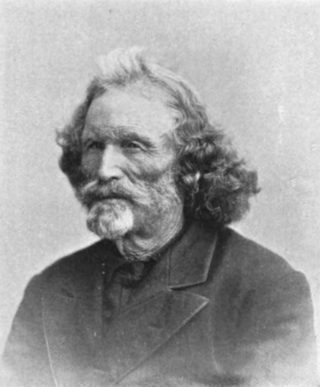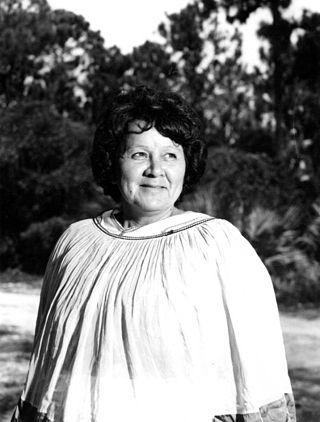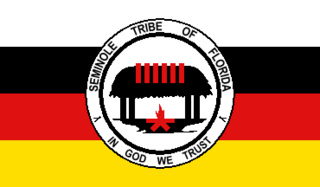Related Research Articles
Jumper or Jumpers may refer to:

The Seminole Wars were a series of three military conflicts between the United States and the Seminoles that took place in Florida between about 1816 and 1858. The Seminoles are a Native American nation which coalesced in northern Florida during the early 1700s, when the territory was still a Spanish colonial possession. Tensions grew between the Seminoles and settlers in the newly independent United States in the early 1800s, mainly because enslaved people regularly fled from Georgia into Spanish Florida, prompting slaveowners to conduct slave raids across the border. A series of cross-border skirmishes escalated into the First Seminole War in 1817, when General Andrew Jackson led an incursion into the territory over Spanish objections. Jackson's forces destroyed several Seminole and Black Seminole towns and briefly occupied Pensacola before withdrawing in 1818. The U.S. and Spain soon negotiated the transfer of the territory with the Adams-Onis Treaty of 1819.

The Second Seminole War, also known as the Florida War, was a conflict from 1835 to 1842 in Florida between the United States and groups collectively known as Seminoles, consisting of Native Americans and Black Indians. It was part of a series of conflicts called the Seminole Wars. The Second Seminole War, often referred to as the Seminole War, is regarded as "the longest and most costly of the Indian conflicts of the United States". After the Treaty of Payne's Landing in 1832 that called for the Seminole's removal from Florida, tensions rose until open hostilities started with Dade battle. For the next four years, the Seminole and the U.S. forces engaged in small engagements and by 1842 only a few hundred native peoples remained in Florida. The war was declared over on August 14, 1842.
The Battle of Lake Okeechobee was one of the major battles of the Second Seminole War. It was fought between 800 troops of the 1st, 4th, and 6th Infantry Regiments and 132 Missouri Volunteers, and between 380 and 480 Seminoles led by Billy Bowlegs, Abiaca, and Halpatter Tustenuggee (Alligator) on 25 December 1837. Halpatter Tustenuggee had played a major role in the Dade Battle two years earlier. The Seminole warriors were resisting forced relocation to a reservation in Oklahoma. Though both the Seminoles and Taylor's troops emerged from the battle claiming victory, Taylor was promoted to the rank of brigadier general as a result, and his nickname of "Old Rough and Ready" came mostly due to this battle.

Jim Baker (1818–1898), known as "Honest Jim Baker", was a frontiersman, trapper, hunter, army scout, interpreter, and rancher. He was first a trapper and hunter. The decline of the fur trade in the early 1840s drove many trappers to quit, but Baker remained in the business until 1855. During that time he was a friend of Jim Bridger, Kit Carson and John C. Frémont. On August 21, 1841, he was among a group of twenty three trappers who were attacked by Arapaho, Cheyenne, and Sioux on what became known as Battle Mountain. After Henry Fraeb was killed, Baker organized the trappers against the Native Americans in a multiple-day fight.
Halleck Tustenuggee was a 19th-century Seminole war chief. He fought against the United States government in the Second Seminole War and for the government in the American Civil War.
Bolek, also spelled as Boleck or Bolechs, and known as Bowlegs by European Americans, was a Seminole principal chief, of the Alachua chiefly line. He was the younger brother of King Payne, who succeeded their father Cowkeeper as leading or principal chief in Florida. Bolek succeeded King Payne in 1812 when he was killed.

Billy Bowlegs III, Billy Fewell, aka Cofehapkee (1862–1965), was a Seminole elder, who was also of African-American descent. He was a tribal historian in Florida.
Ar-pi-uck-i, also known as Abiaka or Sam Jones, was a powerful spiritual alektca and war chief of the Miccosukee, a Seminole–Muscogee Creek tribe of the Southeast United States. Ar-pi-uck-i successfully defied the U.S. government and refused to remove to the Indian Territory west of the Mississippi and his influential leadership in the Second Seminole War (1835–1842) resulted in the permanent Native American presence in Florida.

Betty Mae Tiger Jumper, also known as Potackee (Seminole) was the first and so far the only female chairperson of the Seminole Tribe of Florida. A nurse, she co-founded the tribe's first newspaper in 1956, the Seminole News, later replaced by The Seminole Tribune, for which she served as editor, winning a Lifetime Achievement Award from the Native American Journalists Association. In 2001 she published her memoir, entitled A Seminole Legend.

William Henry Whitaker (1821–1888) was an American Seminole War veteran and pioneer who, under the provisions of the Armed Occupation Act, established the first permanent settlement in what is now Sarasota, Florida. There he traded mullet with Cubans to bring the first groves of economically important oranges to the state. He later married Mary Jane Wyatt and with her raised Nancy Whitaker, the first child recorded in what now is the county of Sarasota and a family of eleven children. His father-in-law, William Wyatt, was a constitutional delegate who helped to originate, and signed, Florida's first constitution. At the end of the Civil War, he helped Judah P. Benjamin escape to London.

The Seminole Tribe of Florida is a federally recognized Seminole tribe based in the U.S. state of Florida. Together with the Seminole Nation of Oklahoma and the Miccosukee Tribe of Indians of Florida, it is one of three federally recognized Seminole entities. It received that status in 1957; today it has six Indian reservations in Florida.
Uchee Billy or Yuchi Billy was a chief of a Yuchi band in Florida during the first half of the 19th century. Uchee Billy's band was living near Lake Miccosukee when Andrew Jackson invaded Spanish Florida during the First Seminole War and attacked the villages in the area. Yuchi Billy and his band then moved to the St. Johns River. During the Second Seminole War, Uchee Billy was an ally of the Seminoles, and was one of the principal war chiefs who fought the U.S. Army.
James Edward Billie, known as Chief Jim Billie, is a politician who chaired the Seminole Tribe of Florida from 1979 to 2001, and again from 2011 to 2016.

Bill Osceola was the first president of the Seminole Tribe of Florida. When the federal government marked his tribe for termination, Osceola came up with the idea of creating a rodeo as a tourist attraction to raise funds. The rodeo earned enough money to pay for tribal representatives to lobby against termination and formally organize as a tribe.

Billy Osceola, was the first elected chief of the Seminole Tribe of Florida. He became an ordained minister and was extremely influential in shifting the Seminole Tribe of Florida from traditional spiritual practices to the Baptist faith. He was the first elected chairman of the tribe after their 1957 reorganization.
Louise Jones Gopher is the second Seminole and the first woman from the Seminole tribe of Florida to earn a bachelor's degree. Gopher, a former director of education for the Seminole Tribe of Florida, was the first female Seminole to earn a bachelor's degree when she graduated from Florida Atlantic University in 1970. Born May 25, 1945, in a chickee at a tribal camp in Fort Pierce, Jones spoke no English when she entered school at age 6. Because they were considered neither black nor white, none of the segregated schools of the day would willingly take her as a student, but at the pleading of her father, Lucie County Schools Superintendent Ben L. Bryan chose to allow her to enroll in the Fairlawn School. In 2014, she was granted an honorary Doctorate of Humane Letters from Florida State University. She is the third Seminole to receive an honorary degree from FSU, after Betty Mae Tiger Jumper and Jim Shore. The Palm Beach Post named her one of the most 100 influential people in Florida in the 20th century.
The Seminole in the American Civil War were found in both the Trans-Mississippi and Western Theaters. The Seminole Nation in the Trans-Mississippi Theater had split alliances. However, the majority of the tribe in the Western territories joined the Union Army under the leadership of Billy Bowlegs. Others, such as John Jumper, supported the Confederacy. The Florida Seminole participated in some skirmishing in central Florida. They were likely at the Battle of Olustee in February 1864.

Fort Basinger's original site is located approximately 35 miles (56 km)west of Fort Pierce, Florida along U. S. Highway 98 in Highlands County, Florida. It was a stockaded fortification with two blockhouses that was built in 1837 by the United States Army. It was one of the military outposts created during the Second Seminole War to assist Colonel Zachary Taylor's troops to confront and capture Seminole Indians and their allies in the central part of the Florida Territory in the Lake Okeechobee region. The Seminole Indians and their allies were resisting forced removal to federal territory west of the Mississippi River as directed by the Indian Removal Act.
References
- Ackerman, Joe A. (1976). Florida Cowman. Kississimme, Florida: Florida Cattlemen's Association.
- Jumper, Betty Mae Tiger (2001). A Seminole Legend: The Life of Betty Mae Tiger Jumper. Gainesville, Florida: University Press of Florida. ISBN 978-0-8130-2285-7.
- Robison, Jim (April 12, 1998). "Seminole Deaths Traced to Failed Courtship". The Orlando Sentinel. Archived from the original on January 26, 2019. Retrieved January 25, 2019.
- Stout, Wesley (March 1, 1965). "Billy Bowlegs Told of How 7 Were Killed". The Orlando Sentinel. Archived from the original on June 7, 2019. Retrieved February 2, 2019.
- "Victims of an Insane Indian" (PDF). The New York Times. March 3, 1889. Retrieved January 25, 2019.